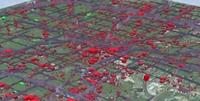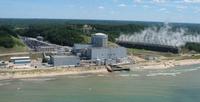-
Study maps greenhouse gas emissions down to building, street level for U.S. cities

Researchers have developed a new software system capable of estimating greenhouse gas emissions across entire urban landscapes, all the way down to roads and individual buildings. Until now, scientists quantified carbon dioxide (CO2) emissions at a much broader level
-
-
New methods might drastically reduce the costs of investigating polluted sites
In Europe there are over 20,000 complex and large contaminated areas. These so-called megasites threaten scarce land and water resources, create environmental and health risks, and result in economic and social costs; new methods may allow polluted sites to be investigated and monitored long term at significantly reduced costs
-
-
NRC sees no evidence of bad security practices at Michigan nuclear plant

The Nuclear Regulatory Committee (NRC) released information last week about a leak earlier this summer at the Palisades plant near South Haven, Michigan; the plant has been mired in controversy this year, as at least three water leaks have occurred in the past several months, and the plant has one of the worst safety ratings in the United States
-
-
Environmentalists concerned about earthquakes tests near California nuclear plant
The Pacific Gas and Electric Company (PG&E) wants to use air guns to emit strong sound waves into a large near-shore area which includes parts of marine reserves; the purpose: creating three dimensional maps of fault zones near its Diablo Canyon nuclear plant in California; the plans have federal and state officials concerned about marine life and public safety
-
-
Dallas area earthquakes were caused by fracking: geophysicists
Three earthquakes that hit a Dallas suburb last week could be connected to fracking operations, according to a local geophysicist who studies earthquakes in the region; the earthquakes were considered minor, with the biggest one registered at a 3.4 on the Richter scale; no injuries were reported despite many emergency calls
-
-
CO2 emissions as a result of economic growth, decline not symmetrical
Estimating the trajectory of CO2 emissions, an important part of planning for climate change mitigation and adaptation, depends in part on understanding how these emissions are influenced by the economy; new study finds that in years when GDP per capita shrinks, CO2 emissions per capita do not decline in equal proportion to the amount by which they increase with economic growth
-
-
Camera for long-range gas leak detection

New infrared gas imaging camera equipped with a 75 mm lens; it iscertified for use in Class I Div 2 hazardous locations, enabling remote detection and visualization of gas leaks from a great distance
-
-
April 2012 Indian Ocean earthquake indicate s that a new tectonic plate is being born
The 11 April 2012 8.7 magnitude earthquake in the Indian Ocean, unlike its 2004 predecessor, did very little damage; it began at one fault, and when it reached an intersecting fault, it ruptured; in total, four different faults were ruptured over the course of 150 seconds; when earthquakes spread to connecting faults, the rupture rips along faults that branch away from the initial fault like branches of a river; the April 2012 earthquakes took a very different course, running along grid-like patterns and making 90 degree turns; the weird rupture pattern reflects the fact that the region is giving birth to a new tectonic plate
-
-
City of Ottawa sits atop soft soil, a geologic features which amplifies seismic waves

Roughly 20 percent of the Ottawa area is built on bedrock, while the remaining area contains unconsolidated surface deposits; this is not good news for city planners – and dwellers – because soft soil amplifies seismic waves, resulting in stronger ground motion than for sites built over bedrock
-
-
Innovative, “complete” solution for oil-spill cleanup
Corncobs, straw, and other absorbents used to clean up oil spills can hold only about five times their own weight and pick up water, as well as oil; scientists describe what may be a “complete solution” to cleaning up oil spills — a superabsorbent material that sops up forty times its own weight in oil and then can be shipped to an oil refinery and processed to recover the oil
-
-
The Western hemisphere’s largest seawater desalination plant to be built in California

The San Diego County Water Authority announced plans to build the Western hemisphere’s largest seawater desalination plant; the plant will produce fifty million gallons of fresh water per day, enough to supply about 7 percent of the San Diego region in 2020
-
-
New study tracks long-term sea-level rise
Greenhouse gas emissions up to now have triggered an irreversible warming of the Earth which will cause sea-levels to rise for thousands of years to come, new research has shown; mankind has already committed itself to a sea-level rise of 1.1 meters by the year 3000 as a result of greenhouse gas emissions up to now; this irreversible damage could be worse, depending on the route we take to mitigating emissions
-
-
Explosives dumped into Gulf of Mexico pose big problems
Millions of pounds of unexploded bombs and other military ordnance that were dumped decades ago in the Gulf of Mexico, as well as off the coasts of both the Atlantic and Pacific oceans, could now pose serious threats to shipping lanes and the 4,000 oil and gas rigs in the Gulf, warns two oceanographers
-
-
Helping improve microbes’ ability to remediate toxic metal contamination
Naturally occurring bacteria in the Gulf of Mexico did a great job helping to clean up 2010’s huge Deepwater Horizon oil spill, but bacteria can do even heavier lifting; routinely used to help clean up toxic metals at contaminated sites, bacteria and other soil microbes are fed to boost their ability to turn soluble metals into solids that will not leech into streams or aquifers
-
-
More ways to combat water shortages
Water is the one element that every breathing, living organism on Earth needs, and unlike oil, there are no viable alternatives; in many undeveloped countries, water is becoming scarce. Concerns are growing about the availability of water in developed countries as well
-
- All
- Regional
- Water
- Biometrics
- Borders/Immig
- Business
- Cybersecurity
- Detection
- Disasters
- Government
- Infrastructure
- International
- Public health
- Public Safety
- Communication interoperabillity
- Emergency services
- Emergency medical services
- Fire
- First response
- IEDs
- Law Enforcement
- Law Enforcement Technology
- Military technology
- Nonlethal weapons
- Nuclear weapons
- Personal protection equipment
- Police
- Notification /alert systems
- Situational awareness
- Weapons systems
- Sci-Tech
- Sector Reports
- Surveillance
- Transportation
Advertising & Marketing: advertise@newswirepubs.com
Editorial: editor@newswirepubs.com
General: info@newswirepubs.com
2010-2011 © News Wire Publications, LLC News Wire Publications, LLC
220 Old Country Road | Suite 200 | Mineola | New York | 11501
Permissions and Policies
Editorial: editor@newswirepubs.com
General: info@newswirepubs.com
2010-2011 © News Wire Publications, LLC News Wire Publications, LLC
220 Old Country Road | Suite 200 | Mineola | New York | 11501
Permissions and Policies
